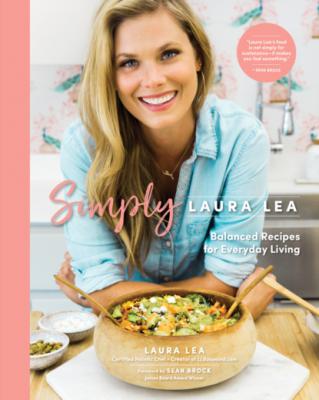Simply Laura Lea. Laura Lea
Читать онлайн.| Название | Simply Laura Lea |
|---|---|
| Автор произведения | Laura Lea |
| Жанр | Кулинария |
| Серия | Laura Lea Balanced |
| Издательство | Кулинария |
| Год выпуска | 0 |
| isbn | 9781951217303 |
key here, and it takes less than five minutes.
Sample Entry: Today I ate oatmeal for breakfast,
tofu tacos for lunch, an apple dipped in yogurt for a
snack, air fryer broccoli plus kabobs for dinner, and
ice cream with 3 or 4 spoonfuls of almond butter for
dessert. I felt great—energetic, happy, and satisfied
until after dinner. I ate my ice cream quickly, then
I kept going back for almond butter. My stomach
was a little bloated and gassy, and I felt overly full.
Caveat: If you have struggled with an eating
disorder or disordered eating, this might not be
the right tactic for you. Work with your therapist
or medical professional to determine if tracking
is a good fit.
Work with a professional: Dovetailing on the
above, if you have developed “food rules,” work
through them with a licensed therapist, dietitian,
or other medical professional. Many people who
have a tumultuous relationship with food choose
meals according to their own self-generated food
rules. I have personal experience with this. When
I had an unhealthy relationship with eating, I had
a rule that I couldn’t have fruit in my breakfast
and mid-morning snack; it had to be one or the
other. I also had a rule that if I had almond butter
with my breakfast, I couldn’t eat any other nut
butters throughout the day. I could eat more
almond butter; I just couldn’t eat peanut butter
or cashew butter. As ridiculous as this may sound,
these rules felt very real to me, and they prevented
me from eating intuitively. I cannot recommend
strongly enough that you seek professional counsel
and help if you feel that you have a disordered
relationship with food.11
11 Disclaimer: I am not a medical professional. All information I share has been gathered through my own experience and research. Please consult a medical professional before making any changes to your diet and wellness routine.
Practice mindful eating: Researcher Ingrid
Elizabeth Lofgren writes, “Mindful eating is a
nonjudgmental acceptance of physical and emotional
feelings while eating or in an eating environment.”12 Studies indicate that mindful eating is associated with weight loss, increased fiber intake, and lower transfat and sugar consumption. To practice mindful eating, give yourself time and space and as few distractions as possible when you eat. Eat slowly. Chew. Notice the flavors, the textures, any sensations associated with enjoying the food. Swallow and reflect on the experience. When I practice mindful eating, I have a much easier time noticing when I am comfortably full and stopping there.
Live in the present: When I allow what I’ve been
eating to determine what I will eat, I often ignore
my body’s actual desires. Perhaps I’ve been on an
indulgent vacation, so I feel that I “should” be craving
a kale salad. And yet, my body wants something
heartier and more substantial, like a burger and
fries. In my experience, if I go for the kale salad
anyway, I will be left unsatisfied, rummaging around
the pantry grabbing handfuls of snacky foods.
As my favorite podcast-host Elizabeth Benton
says, “Every choice is a chance.” Don’t focus
on what you’ve done; focus on the moment you’re
in. Be gentle and forgiving with yourself—you are
not the decisions you’ve made, and you’re never
stuck or “too late.” Whether it is with food, your
career, your relationships, or anything else,
you will lose your way. You will make mistakes.
Because you’re human, and imperfection is knitted
throughout the human experience. What matters
is the perspective you choose to have every day.
When I treat myself with grace and generosity,
I am more likely to make a choice that is healthy
for both my body and my mind.
12 Ingrid Elizabeth Lofgren, “Mindful Eating: An Emerging Approach for Healthy Weight Management,” American Journal of Lifestyle Medicine 9, no. 3 (May 1, 2015): 212–16, https://journals.sagepub.com/doi/abs/10.1177/1559827615569684.
Breaking Down Cooking Mindset Myths
This is for all of you who bought this cookbook
because food pictures are fun to look at, or because
someone told you to, or because you love the idea
of cooking, but you have no intention of actually
making the recipes. As much as I appreciate your
support regardless of intent, you now have the book,
and I want you to get more out of it than a thirty
minute flip-through.
In this section, I am going to break down some of
the main mindset barriers that I see when it comes
to cooking, one by one. (These aren’t only from my
perspective, but also from the perspective of clients
with families.) If you purchased my cookbook with
no plan of actually using it, my guess is that your
reasoning falls into one of the following “Mindset
Myths.” And guess what? I had to work through these
myths myself when I began cooking. So I switched my
perspective and created new “Mindset Truths” about
cooking, and it completely changed the game for me.
Cooking Mindset Myths:
